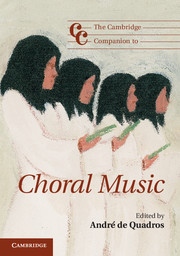Book contents
- Frontmatter
- 1 Introduction: choral music – a dynamic global genre
- Part I Choral music: history and context
- 2 A brief anatomy of choirs c.1470–1770
- 3 Choral music in the culture of the nineteenth century
- 4 Choral music in the twentieth and early twenty-first centuries
- 5 The nature of chorus
- Part II Choral music the world over
- Part III Choral philosophy, practice, and pedagogy
- Notes
- Select bibliography
- Index
- Cambridge Companions to Music
4 - Choral music in the twentieth and early twenty-first centuries
from Part I - Choral music: history and context
Published online by Cambridge University Press: 28 September 2012
- Frontmatter
- 1 Introduction: choral music – a dynamic global genre
- Part I Choral music: history and context
- 2 A brief anatomy of choirs c.1470–1770
- 3 Choral music in the culture of the nineteenth century
- 4 Choral music in the twentieth and early twenty-first centuries
- 5 The nature of chorus
- Part II Choral music the world over
- Part III Choral philosophy, practice, and pedagogy
- Notes
- Select bibliography
- Index
- Cambridge Companions to Music
Summary
During the first two decades of the twentieth century, composers were presented with more stylistic options than at any previous time. While often associated with national schools, these options were not, in reality, confined to them. In America, Charles Ives (1874–1954), laboring in near anonymity, trusted that people who appreciated the simultaneous sounds of separate marching bands in a parade could listen the same way in a concert hall. In France, Claude Debussy (1862–1918), after hearing a Javanese gamelan orchestra, invigorated Western music by subtly blurring ideas of tonality. The Russian Igor Stravinsky (1882–1971) emancipated rhythm in previously inconceivable ways. In Austria, competing ideas emerged: on one hand Gustav Mahler (1860–1911) continued to expand the limits of traditional tonality and form, while on the other Arnold Schoenberg (1874–1951), believing that his muse was the true heir of German Romanticism, experimented first with expanded orchestral timbres before moving on to atonal expressionism and thus to dodecaphony. In England, Sir Edward Elgar (1857–1934) summarized all that was noble in Victorian tradition, while his younger contemporary Ralph Vaughan Williams (1872–1958), driven by impulses similar to his contemporaries Béla Bartók (1881–1945) in Hungary and Leoš Janáček (1854–1928) in Moravia, discovered what could be achieved by a complete assimilation of folk traditions. At the same time, jazz musicians were striving for respectability while Dame Ethel Smyth (1858–1944) in England and Amy Beach (1867–1944) in America were endeavoring to prove that women also could compose music of high quality. In addition, the two world wars had profound impact on choral music. All succeeding composers were thus influenced, in some way, by these people and events and, as the century progressed, they incorporated into their own music the various techniques pioneered during the first two decades of the century.
- Type
- Chapter
- Information
- The Cambridge Companion to Choral Music , pp. 43 - 60Publisher: Cambridge University PressPrint publication year: 2012
- 1
- Cited by



